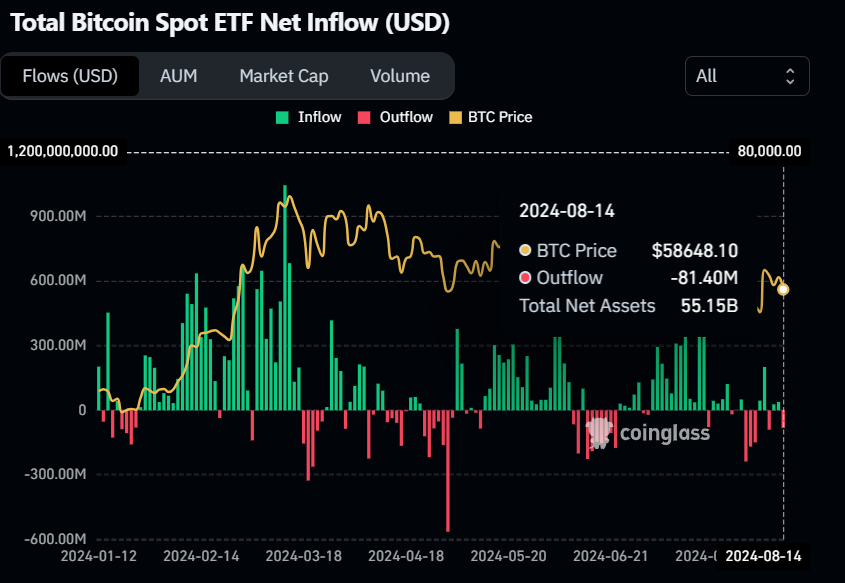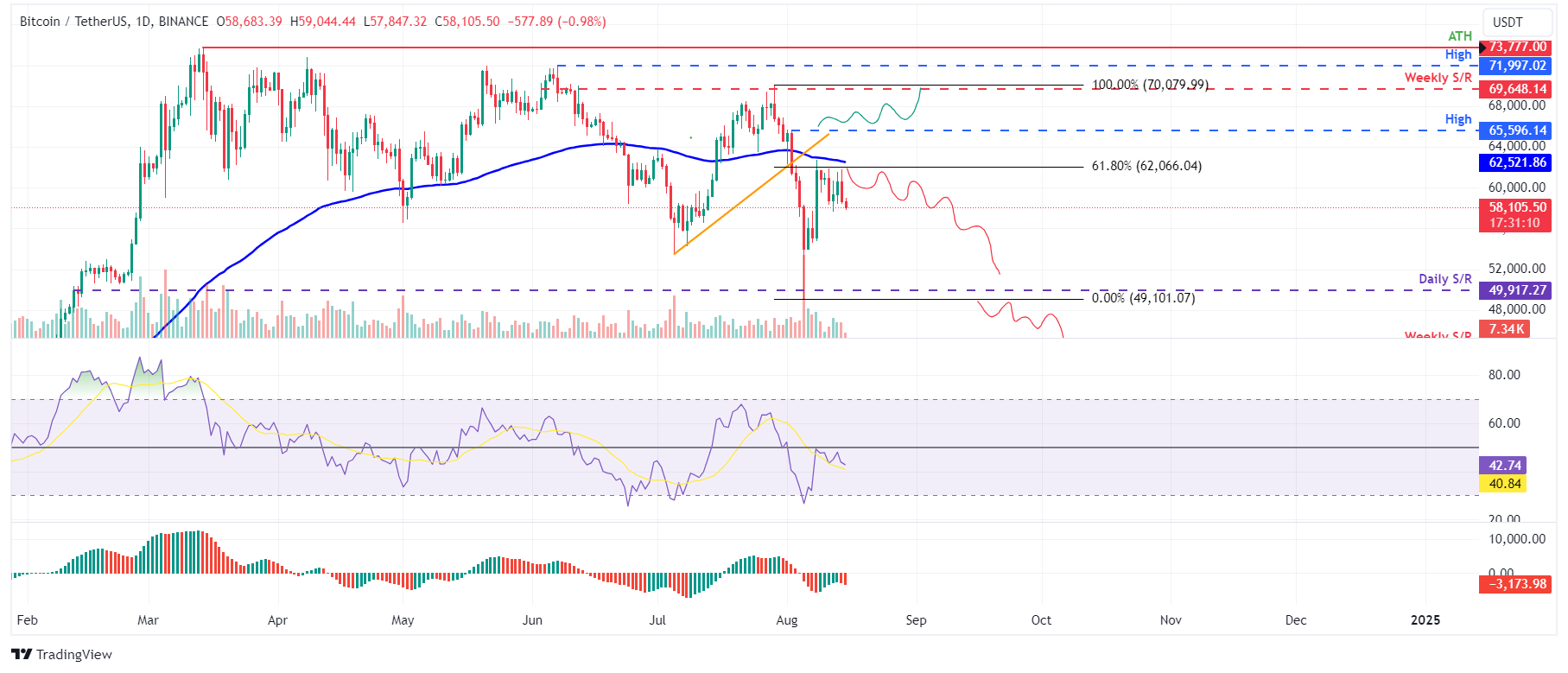- Arkham Intelligence data shows that a wallet associated with the US government transferred 10,000 BTC, worth $593.5 million, to Coinbase Prime on Wednesday.
- Bitcoin Spot ETFs recorded a mild outflow of $81.40 million on Wednesday.
- On-chain data shows that BTC’s daily active addresses are decreasing, signaling a bearish move ahead.
Bitcoin (BTC) price trades in the red for a second consecutive day on Thursday, down by 1.16% at $58,105. Sentiment around the main crypto asset seems to have deteriorated after Arkham Intelligence data showed that a wallet associated with the US government transferred 10,000 BTC, worth $593.5 million, to Coinbase Prime. Additionally, Bitcoin Spot ETFs recorded a mild outflow of $81.40 million, snapping a streak of two days of minor inflows.
Daily digest market movers: US government transfer weighs on Bitcoin
- Arkham Intelligence data shows that on Wednesday, a wallet associated with the US government transferred 10,000 BTC, worth $593.5 million, to Coinbase Prime. These funds were related to Silk Road Confiscated Funds by the US Department of Justice (DOJ).
- Historical data from Lookonchain shows that US government-related transfers earlier this year have led to an approximate 5% drop in Bitcoin’s price within three days. As Wednesday’s transfer of 10,000 BTC was the largest known this year so far, it could generate FUD (Fear, Uncertainty, Doubt) among traders, potentially contributing to a decline in Bitcoin’s price.
BREAKING: 10K Silk Road BTC ($593.5M) moved to Coinbase Prime
Wallet bc1ql received 10K BTC from a known US Government wallet 2 weeks ago. This BTC has just been sent on to 33J, a Coinbase Prime deposit wallet. pic.twitter.com/kNLsiJzL95
— Arkham (@ArkhamIntel) August 14, 2024
- Data from Coinglass shows that US-listed Bitcoin Spot ETFs recorded a mild outflow of $81.40 million on Wednesday. This highlights the importance of monitoring these net flows to gauge market dynamics and investor sentiment. Still, these outflows are very small, considering that the total Bitcoin reserves held by the 11 US spot Bitcoin ETFs are now at $55.15 billion.


Bitcoin Spot ETF Net Inflow (USD) chart
- Santiment’s Daily Active Addresses index, which helps track network activity over time. A rise in the metric signals greater blockchain usage, while declining addresses point to lower demand for the network.
- In BTC’s case, Daily Active Addresses declined 6.5% from Tuesday to Thursday and have been falling constantly since mid-March, indicating that demand for BTC’s blockchain usage is decreasing.
%20%5B12.43.18,%2015%20Aug,%202024%5D-638593112622690990.png)
Bitcoin Daily Active Addresses index chart
Technical analysis: BTC finds rejection around $62,000 level
Bitcoin price has retested and failed to overcome the 61.8% Fibonacci retracement level of $62,066, drawn from the swing high of $70,079 on July 29 to the low of $49,101 on August 5. As of Thursday, it trades down 1.16% at $58,105 at the time of writing.
If $62,066 holds as resistance and BTC continues to decline, it could crash 15% from the current level towards $58,105 and even retest its daily support level of $49,917.
On the daily chart, the Relative Strength Index (RSI) and Awesome Oscillator (AO) trade below their neutral levels of 50 and zero, respectively, suggesting an impending bearish trend.

BTC/USDT daily chart
However, if Bitcoin price is able to close above the August 2 high of $65,596, it would set a higher high on the daily chart, possibly leading to a 6% price increase and testing the weekly resistance at $69,648.
Bitcoin, altcoins, stablecoins FAQs
Bitcoin is the largest cryptocurrency by market capitalization, a virtual currency designed to serve as money. This form of payment cannot be controlled by any one person, group, or entity, which eliminates the need for third-party participation during financial transactions.
Altcoins are any cryptocurrency apart from Bitcoin, but some also regard Ethereum as a non-altcoin because it is from these two cryptocurrencies that forking happens. If this is true, then Litecoin is the first altcoin, forked from the Bitcoin protocol and, therefore, an “improved” version of it.
Stablecoins are cryptocurrencies designed to have a stable price, with their value backed by a reserve of the asset it represents. To achieve this, the value of any one stablecoin is pegged to a commodity or financial instrument, such as the US Dollar (USD), with its supply regulated by an algorithm or demand. The main goal of stablecoins is to provide an on/off-ramp for investors willing to trade and invest in cryptocurrencies. Stablecoins also allow investors to store value since cryptocurrencies, in general, are subject to volatility.
Bitcoin dominance is the ratio of Bitcoin’s market capitalization to the total market capitalization of all cryptocurrencies combined. It provides a clear picture of Bitcoin’s interest among investors. A high BTC dominance typically happens before and during a bull run, in which investors resort to investing in relatively stable and high market capitalization cryptocurrency like Bitcoin. A drop in BTC dominance usually means that investors are moving their capital and/or profits to altcoins in a quest for higher returns, which usually triggers an explosion of altcoin rallies.

























